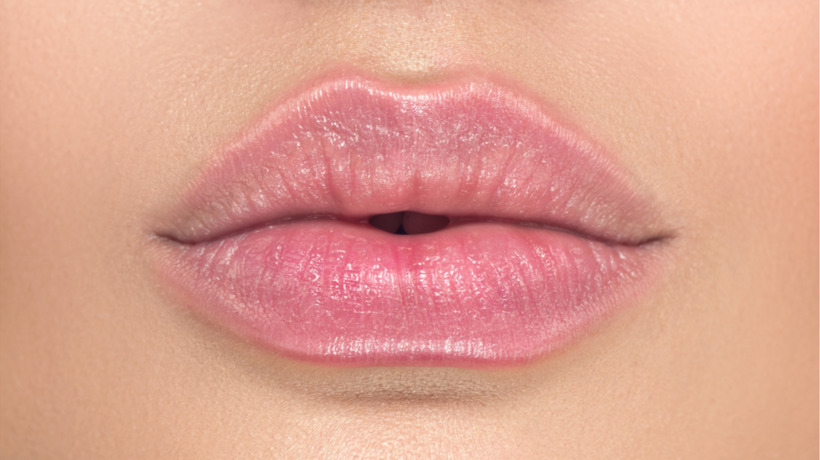Most of us don’t pay much attention to our lips beyond what’s necessary to add a quick swipe of chapstick or lipstick, but according to Dr. Annie Gonzalez, M.D., FAAD, a board-certified dermatologist who spoke with Bustle, the appearance of our lips can hint at what’s going on with our overall health.
According to the PMFA journal, there are two distinct kinds of skin on our lips — the outside part you put lipstick on is called the vermillion, and the inner, wet part is called the mucosal lip. The reason our outer lips are prone to dryness is that they do not have sweat or oil glands like the rest of our skin does.
“While not every new symptom regarding your lips is necessarily concerning, some serious illnesses present signs through the lips,” Gonzalez told Bustle. “It is advised to keep an eye on your lips to see if they change color, texture, or size. If anything about your lips seems out of the ordinary, make an appointment with your dermatologist to receive a medical opinion.”
Below are six symptoms to look out for, and what they could mean for your health.
1. Dry lips
According to Dr. Susan Massick, a board-certified dermatologist at The Ohio State University Wexner Medical Center, “When your skin lacks moisture, it becomes dry — same thing happens on your lips, and they will feel dry and chapped.” But resist the urge to bite or lick the lips in an attempt to moisturize them, Massick says, as “saliva does not moisten the lips — it actually makes them more dry.”
As you might have guessed, this symptom is usually caused by dehydration or dry weather. If you are drinking plenty of water and using lip moisturizer and still have dry lips, the problem might be due to an allergy or contact dermatitis, which is irritation from an external source.
“Lip-licking dermatitis can occur as a result of frequent licking of the skin and the irritation to the skin from the saliva,” Dr. Massick says. “Some people have sensitivity to lip balm ingredients and this can lead to dry, red and irritated lips. People should be particularly careful if the lip balm that they use stings when they apply it — this can actually make things worse and more inflamed.”
2. Cracking in the corners
According to Massick, cracked lips can be caused by a number of conditions, including actinic cheilitis (“cheilitis” means lip inflammation), where cracks are “precancerous changes to the lip usually from chronic sun exposure which runs the risk of skin cancer if left untreated.” In these cases, Massick says, “patients will often notice persistently dry, scaly patches that never heal despite use of moisturizers.”
Another condition which can cause painful sores in the corner of the mouth, and sometimes inside the mouth, is angular cheilitis, which can be caused by malnutrition or fungal infections. Massick says that Down’s Syndrome, diabetes, and auto-immune diseases like Crohn’s disease or Sjögren’s Syndrome can increase your risk of getting angular cheilitis, as can certain vitamin deficiencies, “particularly vitamin B and zinc deficiencies.”
3. Cold sores
Cold sores, which are caused by the herpes simplex virus, are incredibly common, according to the World Health Organization. Typically, symptoms of herpes first show when you first contract the virus, but then may disappear as it lies dormant in your system. At any point, symptoms can be reactivated by stress, lack of sleep, strain on your immune system, sun exposure, or lack of nutrition.
The tell-tale initial signs of oral herpes include contagious sores that form around the mouth and on the lips. “The recurring episodes start with a prodromal burning sensation, followed by a small cluster of blisters that ulcerate and crust over the course of one to three days, Massick explains. “Healing occurs generally in seven to 10 days.”
4. Pale lips or discoloration
Lips that become more pale over time may signify a vitamin deficiency or even skin cancer, according to Gonzalez. Additionally, sudden paleness can be a sign of iron-deficiency anemia, which can be caused by heavy menstrual periods or other blood loss, as well as nutrient loss.
“Pale or discolored lips mean that oxygenated blood is not reaching [them]” Gonzalez says. Lips with a bluish hue might be signaling anemia or possible heart disease, while yellow lips can point toward liver problems.
Dr. Massick adds that whitening of the lips might be seen in squamous cell skin cancer, while a darkening may be linked to melanoma.
Any changes in lip color should be discussed with your doctor.
5. Swelling or tenderness
Swollen lips may be a sign of an allergic reaction to a cosmetic product or food, explains Gonzalez. If you notice this symptom, assess any recent changes in cosmetics or diet, and eliminate them from your routine. If swelling ever impacts your ability to eat or breathe, seek medical attention immediately.
In addition, according to a 2018 study, lip swelling “may be an important symptom of either systemic or local diseases,” from allergies to tumors.
6. Burning and tingling
If your lips are burning even when you’re not eating spicy food, there might be an underlying reason. Burning in the lips, throat, and tongue has been linked to B-12 deficiency, as well as depression and anxiety, and menopause. In addition, your lips can burn from the sun just like the rest of your skin, so be sure to use SPF chapstick!
For more information on common lip symptoms and their possible causes, visit www.Bustle.com.



